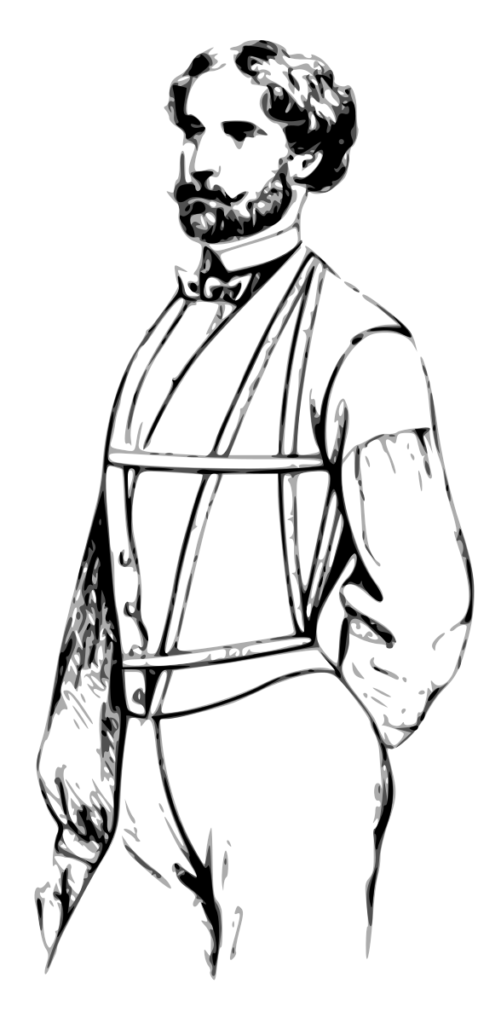Category: Uncategorized
Waistcoat Measurements
This is an introductory course on drafting and constructing a period waistcoat circa 1860 – 1865. As it is intended as for the beginner, I’m leaving out a lot of the more technical information, which can be found in my frock coat drafting class.
Before we can begin drafting our waistcoat pattern, it is necessary to take a few measurements to ensure a good period fit. While a few of the measurements will seem familiar to you, Devere uses some special measurements based on the ‘center point’, which forms the basis for the entire system. Just take things step by step, feel free to ask questions in the forums, and I know you will get it.
To start off, here is an overview of all of the measurements Devere suggests, although the Front Opening measurement is not illustrated. Try to get someone to measure you. While it is possible to measure yourself (I do it all the time), it takes practice and skill, and it’s very difficult if you’ve never used these measurements before.
As you go, write down each measurement in the spreadsheet provided. You can either draft using the measurements that are filled out for you in the spreadsheet, or use the instructions found on the website, which use the graduated measure. You can download both below.
[callout]
- Graduated Rulers
- Measurements Spreadsheet (Libre Office)
- Measurements Spreadsheet (Microsoft Office)
[/callout]
All measurements should be taken over a well-fitted waistcoat, if possible. If you don’t have one, a period shirt will do.
Breast
This measurement determines the size of the graduated measure you should use. Hold the tape around the chest as shown, as high as possible under the arms, and over the fullest part of the chest, holding the tape with the thumb and forefinger of each hand. Draw the tape very tight, and loosen it gently as the client breathes, for the best accuracy. Write this measurement down as half in the chart, i.e. if you have a 48 inch chest, write down 24 in the spreadsheet, since we only draft half of the waistcoat.Waist
This measure it goes around the body on a level with the hollow above the hips, and it should be taken rather easy. Like the breast measure, it is only written down as half the length taken; say 15 ¾ for 31 ½ inches.
This measure, by comparison with the breast, shows if the waist is thin or stout. In the proportionate man it is 15 ¾ or 3 less than the breast.
Waist
This measure is also taken under the coat: it goes round the body on a level with the hollow above the hips, see figure blank, and it should be taken rather easy. Like the breast measure, it is only written down as half the length taken; say 15 ¾ for 31 ½ inches.
This measure, by comparison with the breast, shows if the waist is thin or stout. In the proportionate man it is 15 ¾ or 3 less than the breast.
Finding the Centre Point
The center point forms the basis of finding the next two measurements, and lays out the position of the side seam. Unless you know you have a very accurate waistcoat (which you could use the side seam as the center point), it’s best to manually find the center point.
To find the centre point, we must use the formula of taking 2/5 of the Breast or 1/5 of the full chest and using that number to find the centre point. For example, a 35 inch chest measured all the way around would be 7 inches to the centre point. So find the center of the back at the waist level and measure 7 inches around to find the Centre Point. Or just fill out the spreadsheet and find the center point position that way.
Mark this center point on the client being measured using some chalk in the form of a cross hair +.

Curve
Take the Bust and Curve part of the Tape, slip the eyelet-hole at the end of it over the head of the pin, and hold it there; the eyelet-hole must be exactly at the top of the back seam: then with the other hand carry the tape perfectly straight to the Centre Point, crossing the side seam near the middle, and not letting the tape be either very tight or too slack.

Bust
Continue to hold the end of the tape at the top of back seam, and with the other hand pass the tape over the shoulder in front of the arm, close to the front of the scye, letting the clients arm hang down in its natural position; draw the tape very tight, to flatten any creases there may be at the front of arm, and carry it direct to the Centre Point.

Side
Pass a pencil or penholder through the loop at the end of tape, and hold it tight under the arm (the arm must not be raised up, but should lay close to the body). Then measure the length to the Centre Point, so as to ascertain exactly, the distance between this point and the bottom of scye.
This measure serves to rule the depth of the bottom of scye, and shows the degree in which it must be hollowed out below the side point. In proportionate men it is 8 ½, and is usuallyabout half the length of back to natural waist. It is longer for extra erect men, and for small or high shoulders; and less for stooping men, and for large or low shoulders.

Opening
This is also known as the length of neck seam, and begins at the middle of the back neck and ends at the top of the desired opening in the front, being sure not to measure too tightly or loosely. This is a good measurement to use if you are copying a known vest or style and want the opening at a certain position.

Front Length
The Front Length is measured from the center of the back neck to the bottom of the front, and gives us a reliable way of checking that the length of the vest is correct.

Your Progress
[columns gutter=”0″]
[col]
1 | Take your measurements for the waistcoat. |
[/col]
[col align_text=”center, middle”]
[/col]
[/columns]
